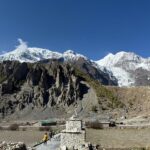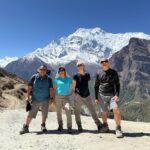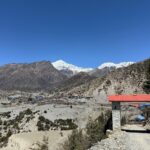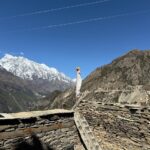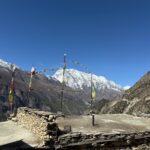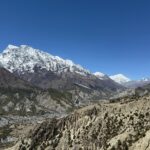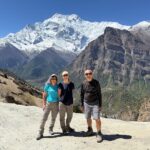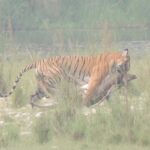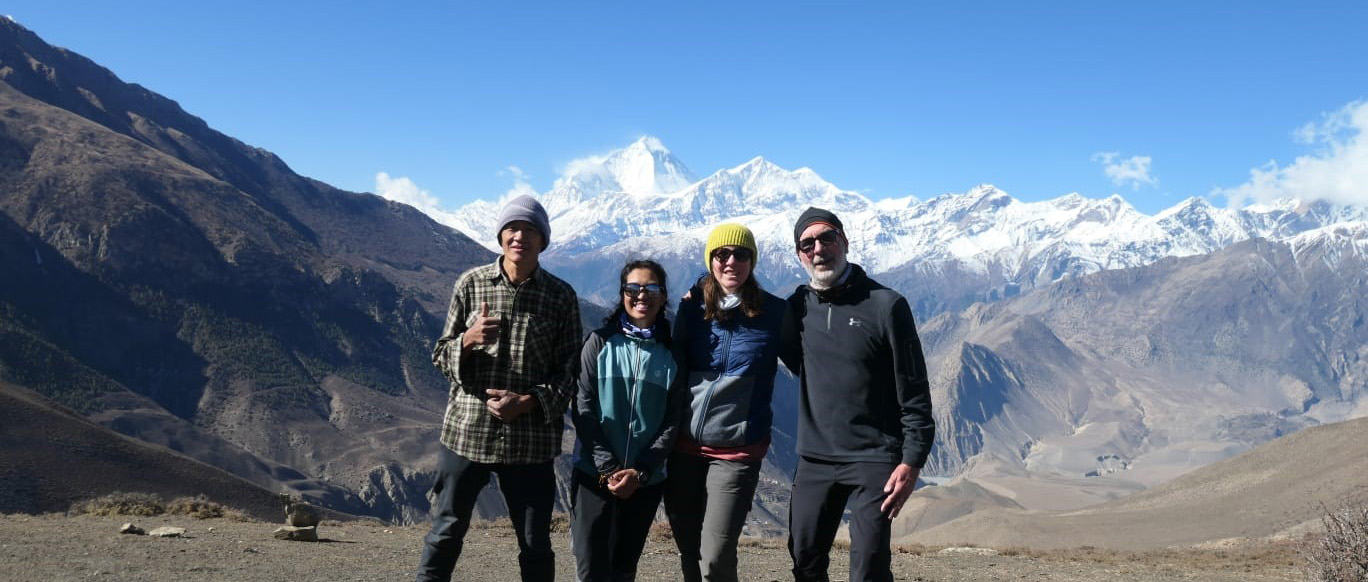
Tea House Trekking in Nepal
Tea House Trekking in Nepal offers a unique opportunity to intimately connect with the locals and immerse yourself in their rich culture and hospitality. Whether you choose to tread the well-trodden paths or explore pristine routes amidst the inviting green hills, an unforgettable experience awaits. Amidst the journey, you’ll encounter enchanting rhododendron forests, deep woodlands adorned with seasonal blossoms, secluded hamlets, quaint mountain villages, cozy cottages, and a captivating array of domestic and wild animals, along with a vibrant tapestry of birdlife.
Tea house trekking stands as the most favored method of exploring the Himalayas, meandering along established trails. It entails a nightly retreat to local tea houses, where you dine and rest. Under the guidance of our seasoned trek leader, your route is meticulously planned, and arrangements are made for meals and accommodations. This ensures that your only concern is shedding your hiking boots and enjoying a warm shower followed by a hearty meal.
While many tea houses and mountain lodges offer a reasonable level of comfort, it’s essential to acknowledge that some may lack cleanliness, and in regions where chimneys are a rarity, rooms might be smoky. Rest assured, your trek guide is committed to ensuring that the places chosen for dining and lodging meet your basic expectations – clean rooms, hot water showers, and a diverse menu featuring delectable local and international dishes.
The beauty of Tea House Trekking lies in its flexibility. By organizing food and accommodation locally through your guide, you have the freedom to set your own pace, craft your schedule, and, most significantly, engage firsthand in the authentic rural life, immersing yourself in the daily experiences of the local people. It’s an unparalleled opportunity to forge genuine connections, gain cultural insights, and savor the true essence of Nepal’s hinterlands.
“To walk in nature is to witness a thousand miracles.” By Mary Davis
Table of Contents
- A typical day in Tea House trekking in Nepal
- Why Tea House Trekking in Nepal
- History of Tea Houses in Nepal
- Food and drinks at local Tea Houses
- Rooms and other facilities at local Tea Houses
- Advantages of Tea House Trek vs camping Trek
- Popular Tea House Trek in Nepal
A typical day in Tea house trekking in Nepal
A typical day on a Tea House trekking in Nepal typically commences at approximately 7:00 am. You have the option to enjoy a light breakfast at your guesthouse, which may include choices like bread, jam, muesli, porridge, and boiled eggs, depending on your preferences.
After this morning nourishment, we embark on our daily trek, commencing our journey into the captivating Himalayan landscape. Typically, we trek for approximately 3-4 hours before breaking for lunch, which typically falls around midday. This provides an opportunity to replenish our energy levels amidst the splendid natural surroundings.
In the afternoon, our trekking endeavors are usually shorter in duration, ensuring that we reach our planned destination in time to indulge in some afternoon tea. This brief respite serves as a moment to relax, unwind, and appreciate the scenic beauty that surrounds us.
During the remaining hours of the afternoon, you may choose to explore the quaint village we have arrived at, tend to any laundry needs, or simply bask in the serenity with a captivating book.
As the day concludes, we gather for a hearty dinner, sharing stories and experiences from our trekking adventures. Evenings often consist of friendly card games, allowing us to relive the day’s memorable moments. Finally, we retire for a well-deserved and restful night’s sleep.
The routine is similar for each day of your trek, ensuring a well-structured and fulfilling journey through the breathtaking landscapes of Nepal.
Why Tea House Trekking in Nepal
Tea houses in Nepal is widely recognized as one of the most exceptional ways to immerse oneself in the country’s breathtaking landscapes, vibrant culture, and welcoming hospitality. There are several compelling reasons why tea house trekking is often considered the preferred choice for trekking in Nepal.
Tea houses offer trekkers a convenient and comfortable option for lodging and meals along the trekking route. This eliminates the necessity for trekkers to carry their own camping gear and food supplies. This convenience enables trekkers to fully concentrate on the journey itself.
Staying in teahouses provides trekkers with the opportunity to engage in close interaction with local communities. By engaging with the people you meet along the way, it offers a unique opportunity to learn about Nepali culture, traditions, and daily life.
Nepal provides a wide selection of tea house trekking routes that cater to different fitness levels and personal preferences. Whether you prefer shorter and easier treks or challenging high-altitude adventures, there is a trek available to suit everyone’s preferences.
Trekking in Nepal offers a breathtaking experience of scenic beauty, showcasing magnificent landscapes such as majestic Himalayan peaks, vibrant forests, terraced fields, flowing rivers, and picturesque villages. Every day offers stunning views and incredible natural beauty.
Cultural immersion is achieved through trekking, as it provides trekkers with the opportunity to witness and participate in local customs, festivals, and religious practices within villages and settlements. During your visit, you will have the opportunity to explore various culturally significant sites such as monasteries, temples, and more.
Teahouses offer a diverse selection of Nepali and international dishes, making them a delightful destination for delicious cuisine. Trekkers have the opportunity to enjoy a variety of culinary delights, including local specialties such as dal bhat (a delicious lentil soup served with rice) and momo (delectable dumplings). Additionally, there are also international dining options available to cater to different tastes. Teahouses frequently offer nourishing meals to replenish trekkers’ energy.
Flexibility is a key advantage of tea house trekking. It enables trekkers to easily modify their itinerary according to their personal preferences, desired pace, and unexpected factors like weather fluctuations. The flexibility adds to the overall experience of trekking.
Opting for teahouse trekking is a great way to contribute to the local economy as it directly benefits guesthouse owners, cooks, porters, and guides. It promotes the development of sustainable tourism in rural areas.
Safety is enhanced on the trail by staying in tea houses that are equipped with trained and knowledgeable guides. Guides are available to offer assistance in the event of altitude sickness or any other health concerns.
Teahouses that prioritize environmental responsibility play a crucial role in promoting eco-friendly practices. By implementing effective waste management strategies and responsibly utilizing resources, these teahouses actively contribute to the conservation of the environment in trekking regions.
Tea house trekking is an excellent option for solo travelers. They have the flexibility to join group treks or hire guides and porters as required, which guarantees a secure and pleasant journey.
Tea house trekking provides an opportunity to create lasting memories through meaningful
from various parts of the world. Adding a social dimension to the journey, sharing stories and experiences with fellow adventurers who share similar interests is a valuable aspect.
Tea house trekking in Nepal is renowned for its unique combination of comfort, cultural immersion, natural beauty, and convenience. Trekkers have the opportunity to explore a variety of routes in Nepal’s trekking regions, allowing them to connect with local communities and fully appreciate the unique charm of each area. The allure of tea house trekking in Nepal is undeniable, whether you are a novice trekker or an experienced hiker.
History of Tea Houses in Nepal
In 1964, Jimmy Roberts orchestrated the inaugural trek in Nepal through Mountain Travel. During the early phase of trekking in Nepal, expedition groups relied on comprehensive camping support, akin to the style employed in mountaineering expeditions. Concurrently, the Hippie trail was gaining momentum, with its epicenter situated around the historic Freak Street in Kathmandu. Notably, some individuals from this trail ventured into the mountainous regions and opted to stay in local village homes.
As the number of trekkers surged throughout the 1970s, these initial homestays gradually evolved into what we now know as teahouses. By the 1980s, a substantial network of teahouse lodges had been meticulously constructed across Nepal’s primary trekking destinations. These lodges provided essential amenities and accommodations for trekkers, marking a significant transformation in the trekking experience.
Food and drinks at local Tea Houses
Teahouses in Nepal offer a diverse range of cuisine, including both Western and local options such as Nepali, Tibetan, and Chinese dishes. The level of sophistication and variety of food can vary based on the remoteness of the trekking route.
In well-traveled and popular trekking regions, teahouses often provide a wide array of culinary delights. You can relish treats like apple pies, homemade pizzas, and freshly brewed coffee. Meals are typically enjoyed together in the teahouse’s cozy dining room, often accompanied by the warmth of a wood-burning stove. Here, each trekker can freely select their preferred items from the menu, ensuring that dietary preferences are accommodated, and you are not restricted in your choices. Payments for meals are made individually unless you have opted for an all-inclusive package with us.
If you’re on an all-inclusive journey with our team, you have the flexibility to choose your preferred dishes from the menu. It’s important to note that as you venture into more remote and distant areas, the cost of food and beverages may increase. This is due to the logistical challenges of transporting supplies by porters, yaks, or donkeys. Nevertheless, even in the most isolated destinations, the prices for food remain quite reasonable, considering the effort required for transportation.
Rooms and other facilities at Local tea houses
The quality of lodges in Nepal’s trekking regions varies depending on their location and the level of trail traffic. In areas with heavy trekking activity, such as the Everest Base Camp route, you can generally expect better facilities. Some lodges in Nepal operate as large commercial establishments, offering up to thirty rooms. However, a general rule of thumb is that the higher the altitude, the more basic the lodge facilities become. Running a guesthouse at elevations exceeding 4,000 meters poses significant challenges.
A typical teahouse lodge features a central dining room equipped with an evening heater. The type of fuel used for heating can vary, with wood being common at lower altitudes and dried yak dung at higher elevations. You’ll likely spend a considerable amount of your leisure time in this communal area. It’s a good idea to bring along a book, playing cards, or games to keep yourself occupied, as trekkers often have free time to spare. Additionally, this shared space provides an excellent opportunity to meet fellow trekkers from different parts of the world and exchange trekking experiences.
Most lodges offer private bedrooms with twin beds and shared bathroom facilities. However, it’s worth noting that due to limited accommodation options at Annapurna Base Camp, only dormitory-style rooms are available on this trek. In such cases, you may find yourself sharing a room with four or five other trekkers who may not be part of your trekking group.
The beds typically have foam mattresses, which may feel firm to some. If you prefer a softer sleeping surface, consider bringing an inflatable mattress like a Thermarest. Bedding is not provided, but you might find a sheet covering the mattress and occasionally a pillow. It’s essential to bring a warm sleeping bag as the lodge rooms are not heated.
Toilet facilities in lodges can vary. Lower-altitude lodges often have Western-style flushing toilets. However, at higher elevations where freezing temperatures are common, squat toilets are more prevalent. In some cases, particularly at higher lodges, there are outdoor long-drop toilets.
Many lodges provide hot showers, although the quality and availability can vary. In larger villages like Namche Bazaar, hot water is often generated using solar heating systems. In contrast, at higher altitudes, you may only have access to a bucket of warm water for a wash.
Electricity is available in most places, making it possible to recharge batteries for your devices. Additionally, many lodges offer Wi-Fi access. In certain regions such as Everest, Upper Mustang, and Langtang, you can purchase an Everest Link prepaid card for data, which can be used at lodges along the trekking route.
Recently, more lodges have started offering rooms with attached bathrooms. These range from basic rooms with only a toilet to more well-equipped options with a toilet, wash basin, and even a shower.
Advantages of Tea House Trek vs Camping Trek
Trekking with a lighter load means packing fewer clothes and gear in comparison to a camping trek. This not only reduces the weight you need to carry but also makes it a more cost-effective option, as it requires fewer porters and kitchen staff for transporting tents and food supplies.
Opting for teahouse trekking is a wonderful way to contribute to the local economy and provide support to local families who operate these lodges.
When it comes to meals, you have the freedom to choose from a menu and select dishes that suit your preferences. This is in contrast to camping treks where the cooks typically prepare a set menu for the entire group.
Teahouse trekking offers a social experience where you can interact with fellow trekkers in the evenings. In quieter lodges, you have the opportunity to meet the lodge owners and engage in conversations with them. On occasion, you may even dine with the lodge owner’s family in the lodge’s kitchen, further enhancing the cultural exchange and personal connections you can make during your trek.
Popular Tea House Treks in Nepal
- Everest Base Camp Trek, 15 days
- Everest Gokyo Lake Trek, 14 days
- Everest High Passes Trek, 19 days
- Everest Panorama Trek, 11 days
- Annapurna Base Camp Trek, 11 days
- Annapurna Circuit Trek, 15 days
- Jomsom Muktinath Trek, 10 days
- Ghorepani Poonhill Trek, 9 days
- Mardi Himal Trek, 11 days
- Langtang Valley Trek, 9 days
- Gosainkunda Trek, 10 days
- Tamang Heritage Trek, 10 days
- Manaslu Base Camp Trek, 15 days
- Manaslu Circuit Trek, 13 days
- Manaslu Tsum Valley Trek, 20 days
- Upper Mustang Trek, 16 days

